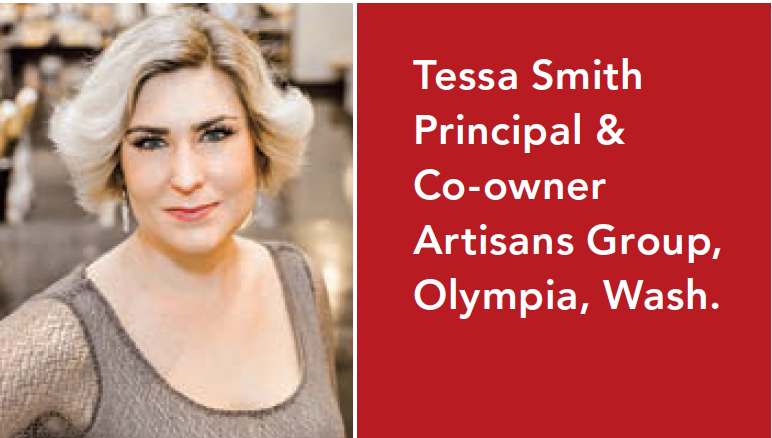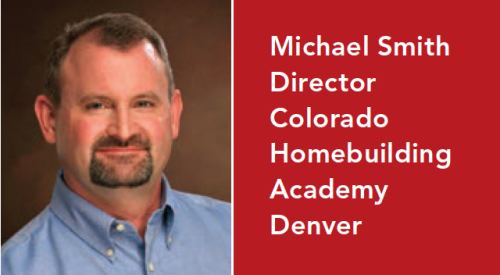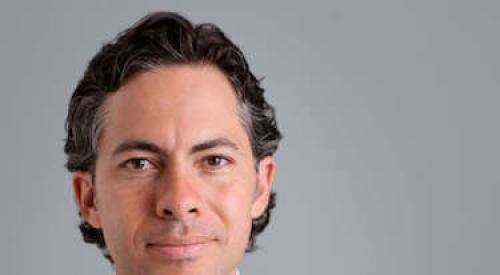As a young girl, Tessa Smith was fascinated by watching her father, a drafting teacher at the local community college, set up his studio in the family laundry room to draw. He also was a carpenter who made furniture and fought back decrepitude in the family’s Craftsman home with many remodeling projects. Between spending time in her dad’s workshop and making dollhouses and Lego cities, Smith became enamored of building. She was home schooled by her mother—“She was brilliant and extremely grueling when it came to school”—and enrolled in college at age 15. She took her father’s drafting course, liked it, graduated with a technical trade degree at 17, and was hired at her first drafting job by claiming she was 18.
While working full-time drawing, she attended the local liberal arts college and pursued a non-standard bachelor’s degree in sustainable architecture, design, and fine arts. Before graduating, Smith landed at Artisans Group, developed an interest in Passive House, and became a certified Passive House consultant at age 22 and eventually a co-owner. To complete the licensure process, she accrued work service hours by hiring an architect to oversee what essentially was an internship at her own company. Smith became a licensed architect, and her firm is building Passive Houses with prerefabricated walls and roof assemblies at just 5 to 10 percent more than the cost of an equivalent-sized code-built tract home.
Q: Your career path for becoming an architect was non-traditional. Can someone do today what you did to become an architect?
A: I feel that the voice I am supposed to have in our industry is to encourage training and experience. I’m really saddened to see the [architecture] community go away from alternative pathways to licensure because [Washington] is one of the last states where you can have a non-conforming degree like mine and become an architect.
I think that is profoundly sad because those who would have the talent and drive but not the financial means to attend an NCARB (National Council of Architectural Registration Boards) supported school can’t become architects. I get it that the profession is not something anybody can do. It should be difficult and one should be qualified. But a few years ago, less than 11 percent of licensed architects in the U.S. were women because the industry is geared to full-time employees who don’t take the time off for family or travel. So you have an entire industry based on a certain kind of way you rise in the ranks that was discriminatory to women and to anybody who doesn’t travel the exact path. In recent history there used to be a lot of ways to become an architect. I believe the industry has lost something in its more myopic approach to licensure. I do feel myself becoming an advocate for young women, and I would definitely attend any [legislative session} in our state that would propose to remove the path I took to become an architect because I think it is critical to the health of our industry.
Q: What kind of reaction have you received from that point of view?
A: On a personal level of advocacy, I find that most architects want employees who can problem solve; who care and get along with other people.That one star student who is an incredible designer has a place too, but more often than not [architects] are going to want someone who is going to fit in with their company culture. I don’t feel a lot of resistance toward alternative licensing paths from most of the architects I know, but most of the architects I know are in the Passive House community, and they’re sort of thinking differently anyway. They’re open-minded people who don’t want to build a house the same way it’s been done for the last 200 years if it doesn’t make sense. So I feel like they’re ripe ground for change.
Q: You were drawn to Passive House because you got tired of all the green washing. What was going on then?
A: I don’t want a product that is no different than what I could buy 10 years ago. That is what most of the houses that claim to be green are today.
I want something that is going to last, is going to be super comfortable, and is going to consume less resources. And while I’m working toward that, I’m going to want to focus on the big points. I want to make sure that I am not hurting people when I’m extracting things from the earth. I want to make sure I am paying my employees fairly and giving them as many benefits as I can so I’m participating in my community, and I want to do projects that aren’t just money makers but actually make a difference for the community that we build them in.
Half of our firm does Passive House because we can build 10 Passive Houses for the resource impact of one regular home, if we look at the lifetime impact of its energy use, while being more comfortable, more healthy, and lasting longer. So now instead of a sheetrock palace rotting away behind its T1-11 siding, you’ve got something you can actually pass to your children or sell as an asset that is not a depreciating item. This is something that has value a hundred years into the future. And that has overarching ripple effects to how we even finance it. Half the firm is doing passive house, and we want to get into multifamily passive house because it makes so much sense to build these large really sustainable passive house projects that perform amazingly well.
The other half of our firm is doing commercial work. We did a very notable project called 222 Market, which was a landmark for our city because (Olympia) never permitted anything like this before (former office building was converted to a Euro-style artisan food market and dining hub). It was extremely difficult. We had to work with a lot of agencies. We had to be marketers. We had to figure out leases. We had to participate in the building program all just as an architect and contractor, right. We were convincing people to get on board. It’s an open-air market in an old building that we repurposed, and it’s become the tourist destination for Olympia. Olympia has had a struggling downtown for decades, and we’ve done about four or five projects there in the last two years in an attempt to participate in the social equity of our community and the urban fabric that we are trying to improve.
Q: Back in 2013 when the German and American Passive House institutes stopped collaborating with each other on software, testing, and certification, the Artisans Group split consulting collaboration for your Passive House projects then between the Germans and the Americans. What did you learn?
A: There are a lot of people that feel very passionate about the politics involved. We were passionate about staying out of it and we were passionate about continuing to do the good work regardless of who was certifying it because they both have really wonderful ideals. The Germans were trying not to compromise because compromise can be the beginning of the diffusion of certification like LEED, and they didn’t want that to happen. But PHIUS (Passive House Institute US), they understood that there were elements in the PHI brand and approach that simply won’t work in the American market for cultural reasons. We have a building industry completely entrenched in how we do things and even financing, government support and all those things are completely different in the German market than here. So PHIUS tried to make some subtle changes that would allow the brand to be more applicable and more effective in the American market. The Germans saw that as a compromise and PHIUS saw it as a way to actually make this work in America. So you can see both their points of view and neither are wrong. In my opinion both are right because they both are protecting their brand.
Q: Are you seeing more U.S.-made, Passive House-certified products that Artisans would consider using for its projects?
A: We’ve gone from having no options in the U.S. to having several good options in the U.S. they are still under heavy competition with some really excellent imported products and if you really examine the data, in some ways, imported a very sustainable product from Europe, can often times still trump the carbon footprint of an American made product, so understanding what you are buying and weighing out the cost of quality still has to be done. There were two places I could buy windows (PH certified) even get them in America when I started seven years ago and now there are so many companies (manufacturers) at these conference now, I don’t even know how many there are. It is a fantastic growing industry in terms of the vendorship.
Q: How do you respond to the notion in that the financial payback for a Passive House buyer would take substantially longer compared with the recoup period for housed built to other energy code standards?
A: It’s more like what are you comparing it to because if I went to build a Passive House tract home, I know from experience I can get to within 5 to 10 percent of the cost of an equivalent code built tract home. I also know from Randy’s financial model that that can pay off in 5 to 10 years given the reduction in energy usage. (Editor’s note: Randy Foster is a principal and co-owner of Artisans Group who developed spreadsheets to show the financial payback comparison between the upfront and the operating costs of a Passive House). That’s not hearsay, that is math. That’s even considering the opportunity cost of the loss of money (that you will pay to build PH) that’s a real payback model. On a custom home, which is more of what we do, and a lot of it is for middle class people, they’re not million dollar homes, The sweet spot for most of our custom work is half a million to a million (dollars) for most of our custom work which is pretty competitive for Seattle. So you got a home that you already weren’t going to buy the cheapest vinyl windows. You probably were going to buy something nice like a Marvin or a Pella. And you probably weren’t going to put in the cheapest furnace system you could buy, which is exactly what they do in a spec home. So the minute you’re not buying the cheapest window and the cheapest heating system, I have a zero percent upgrade for a passive house, zero to two percent on some projects. You literally are buying more insulation and more attention and detail to craftsmanship because it has to be airtight. You’re already going to build a great house because it is a custom. You’re going to pay more for it because it is a higher quality house than you would pay on the spec market. So the minute you compare apples to apples, passive house has a very low upgrade cost if any and then you look at the energy savings and that becomes money in you pocket almost immediately. We have custom homes that pay back in three to five years.













